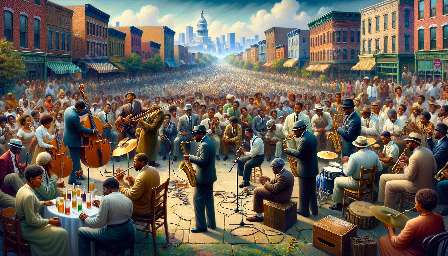Jazz and blues music have deep historical roots that have evolved over time, influencing various musical genres and cultures. Understanding their origins, development, and pedagogy can provide insights into these rich musical traditions.
Historical Roots of Jazz and Blues Music
Jazz and blues have their origins in the African American experience, rooted in the rich musical traditions brought by enslaved Africans to the Americas. The early forms of blues emerged in the late 19th century from the Mississippi Delta, drawing from African musical influences, field hollers, work songs, and spirituals. Blues music served as a means of expressing the joys and sorrows of everyday life, often characterized by its twelve-bar structure, call-and-response patterns, and emotional vocals.
On the other hand, jazz originated in the diverse cultural melting pot of New Orleans, blending African rhythms, European harmonies, and American brass band traditions. The syncopated rhythms, improvisation, and collective creativity became defining features of jazz music, making it a vibrant and evolving art form.
Evolution of Jazz and Blues Music
Over the years, jazz and blues music have evolved in response to social, cultural, and technological advancements. The Great Migration in the early 20th century brought the blues to urban centers, leading to the electrification of the music and the development of urban blues styles. Similarly, jazz underwent various stylistic changes, from the New Orleans jazz of Louis Armstrong to the bebop revolution of Charlie Parker and Dizzy Gillespie.
The mid-20th century marked the rise of diverse subgenres within jazz and blues, including swing, boogie-woogie, jump blues, and big band jazz. The influence of Latin, Caribbean, and African rhythms further expanded the musical vocabulary of jazz, leading to the emergence of fusion and avant-garde jazz in the late 20th century.
Pedagogy for Teaching Jazz and Blues Music
Teaching jazz and blues music involves imparting historical knowledge, developing instrumental and vocal skills, and fostering an understanding of cultural contexts. Effective pedagogy for these genres focuses on the following aspects:
- Historical Context: Educating students about the historical roots and evolution of jazz and blues, including key musicians, movements, and influential recordings.
- Technique and Theory: Instructing students in the technical aspects of playing instruments, vocal techniques, improvisation, and music theory relevant to jazz and blues.
- Listening and Analysis: Encouraging students to actively listen to a wide range of jazz and blues recordings, analyze musical structures, and appreciate the diversity of styles within these genres.
- Performance Opportunities: Providing platforms for students to showcase their skills, collaborate with peers, and participate in ensemble playing to experience the communal aspect of jazz and blues music.
- Cultural Understanding: Exploring the social and cultural contexts of jazz and blues, highlighting the contributions of diverse communities and the impact of these genres on popular culture.
Pedagogy for jazz and blues music aims to nurture creativity, critical thinking, and cultural appreciation among students while preserving the authenticity and traditions of these musical genres.
Conclusion
The historical roots of jazz and blues music are deeply intertwined with the African American experience, evolving over time to become global phenomena. Understanding the historical and cultural contexts of jazz and blues, along with effective pedagogical approaches, can enhance appreciation for these genres and inspire future generations of musicians to carry forward their legacy.






























